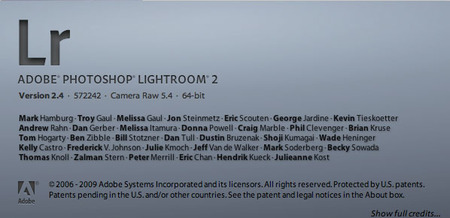Lightroom 2.4 and Camera Raw 5.4 are now available as final releases on Adobe.com and through the update mechanisms available in Photoshop CS4 and Lightroom 2. These updates include camera support for the following models:
- Canon EOS 500D (Digital Rebel T1i/EOS Kiss X3 Digital)
- Canon PowerShot SX1 IS
- Epson R-D1x
- Hasselblad CF-22
- Hasselblad CF-22MS
- Hasselblad CF-39
- Hasselblad CF-39MS
- Hasselblad CFH-22
- Hasselblad CFH-39
- Hasselblad CFV
- Hasselblad 503CWD
- Hasselblad H2D-22
- Hasselblad H2D-39
- Hasselblad H3D-22
- Hasselblad H3D-31
|
- Hasselblad H3D-39
- Hasselblad H3DII-22
- Hasselblad H3DII-31
- Hasselblad H3DII-39
- Hasselblad H3DII-39MS
- Hasselblad H3DII-50
- Kodak EasyShare Z980
- Nikon D5000
- Olympus E-450
- Olympus E-620
- Panasonic Lumix DMC-GH1
- Pentax K-7
- Sigma DP2
- Sony A230
- Sony A330
- Sony A380
|
|
Note: Hasselblad support is for the 3FR file format only. The Hasselblad FFF file format is not currently supported.
|
Lightroom 2.4 Bug Fixes
The Lightroom 2.4 update includes several bug fixes. The following is a list of items FIXED in this release.
- Web galleries with a Collection Title of six characters would not export or upload
- The crop aspect ratio could revert to the last selected ratio even when reset to original
- The crop aspect ratio in Quick Develop could be lost after a crop adjustment
- The crop aspect ratio lock could be lost after an orientation switch
- Images could preview incorrectly when imported using the MTP/PTP USB protocol
- Sony .ARW files may not have been recognized by Lightroom’s import dialog
- The Japanese language configuration of Lightroom on Mac OS X 10.5 could fail to switch to the print module if the HP B9180 was set as the default printer
- Metadata options that are intended for use were dimmed incorrectly when exporting DNG files
- The Japanese language configuration of Lightroom on Mac OS X was missing a shortcut for “Zoom Out”
- Several translation and shortcut corrections were made for the eight additional languages introduced with Lightroom 2.3
New Lightroom 2.4 and Camera Raw 5.4 DNG Options
This release includes new DNG Compatibility conversion options. These choices help address the additional options available with the new DNG 1.3 Specification (http://www.adobe.com/dng):
- Camera Raw 2.4 and later: The DNG file will be readable by Camera Raw 2.4 (Photoshop CS) and later, and Lightroom 1.0 and later
- Camera Raw 4.1 and later: The DNG file will be readable by Camera Raw 4.1 (Photoshop CS3) and later, and Lightroom 1.1 and later. The DNG file will often be readable by earlier versions, depending on the camera model
- Camera Raw 4.6 and later: The DNG file will be readable by Camera Raw 4.6 (Photoshop CS3) and later, and Lightroom 2.1 and later. The DNG file will often be readable by earlier versions, depending on the camera model
- Camera Raw 5.4 and later: The DNG file will be readable by Camera Raw 5.4 (Photoshop CS4) and later, and Lightroom 2.4 and later. The DNG file will often be readable by earlier versions, depending on the camera model
- Custom: (Not available in Lightroom 2.4)
- Backward Version Option: DNG 1.1, DNG 1.3 (default 1.3)
- Checkbox: Linear (demosaiced) (default unchecked)
- Checkbox: Uncompressed (default unchecked)
DNG 1.3 Specification Update
The DNG specification has been updated to version 1.3.[LINK] The update includes the following changes:
- In Chapter 2, “DNG Format Overview”, the section on Defective Pixels has been updated
- The section on Opcode Lists has been added to Chapter 2, “DNG Format Overview”
- The CFALayout tag has been updated in Chapter 4, “DNG Tags”.
- Additional Tags for Version 1.3.0.0 were added to Chapter 4, “DNG Tags”
- Chapter 7, “Opcode List Processing” was added.
- “Appendix A: Compatibility with Previous Versions” was updated.
The additional "Opcode Lists" allow complex processing to be moved off the camera hardware, which can have limited processing power, and into the DNG reader, which is often running on more powerful hardware. This also allows processing steps to be specified, such as lens corrections, which ideally should be performed on the image data after it has been demosaiced, while still retaining the advantages of a raw mosaic data format.
